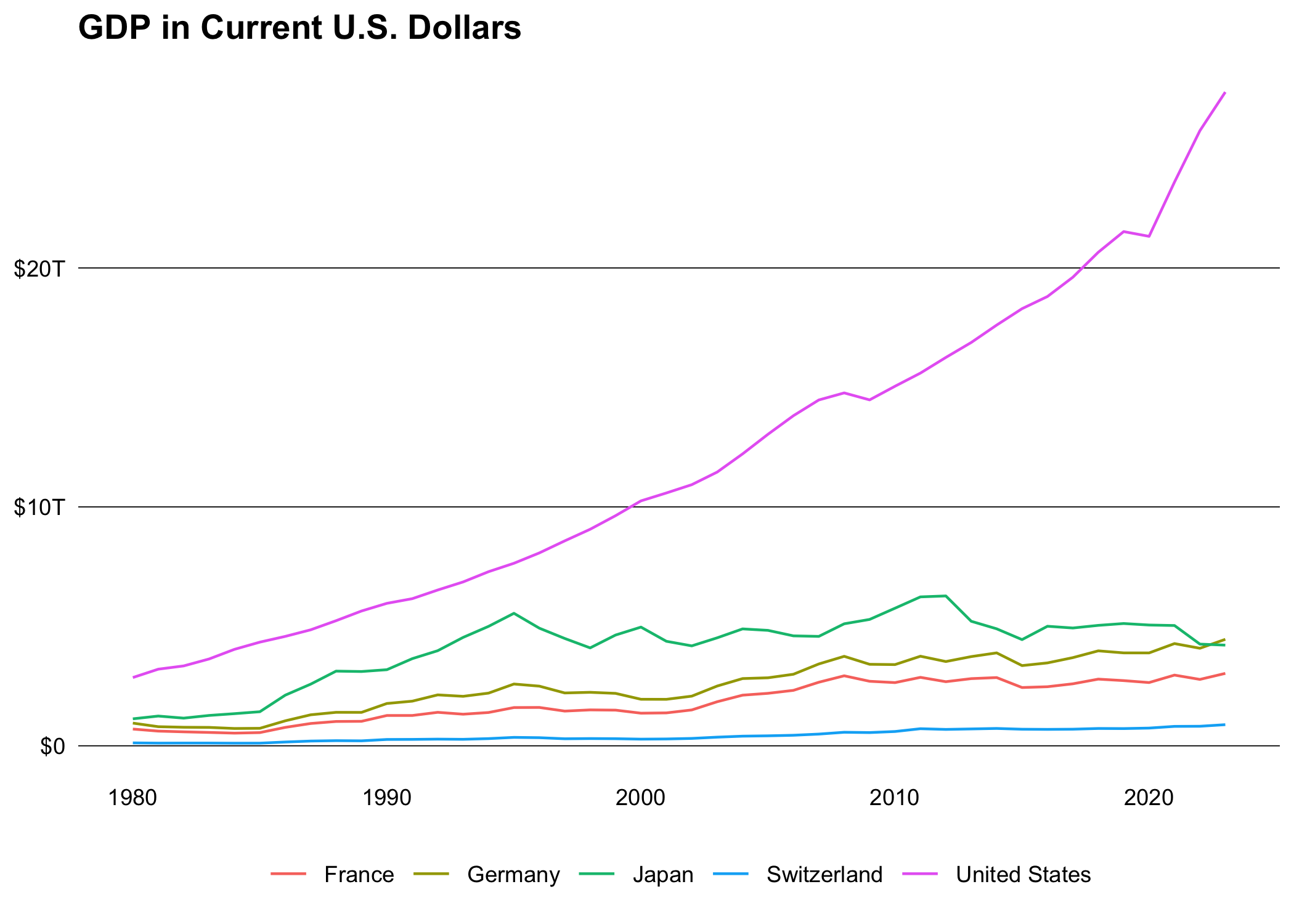Description
Client for World Banks's 'Indicators' and 'Poverty and Inequality Platform (PIP)' APIs.
Description
Download and search data from the 'World Bank Indicators API', which provides access to nearly 16,000 time series indicators. See <https://datahelpdesk.worldbank.org/knowledgebase/articles/889392-about-the-indicators-api-documentation> for further details about the API.
README.md
worldbank
Overview
worlbank provides a simple interface to the following World Bank APIs:
The main difference to other packages is that it’s a modern implementation using the httr2 package and supports all available endpoints and parameters.
Installation
You can install the released version of worldbank from CRAN with:
install.packages("worldbank")
And the development version from GitHub with:
# install.packages("pak")
pak::pak("m-muecke/worldbank")
Usage
worldbank functions are prefixed with wb_ and follow the naming convention of the World Bank API v2.
library(worldbank)
# filter by specific country
wb_country(c("US", "DE"))
#> country_id country_code country_name region_id region_code
#> 1 DEU DE Germany ECS Z7
#> 2 USA US United States NAC XU
#> region_value admin_region_id admin_region_code admin_region_value
#> 1 Europe & Central Asia <NA> <NA> <NA>
#> 2 North America <NA> <NA> <NA>
#> income_level_id income_level_code income_level_value lending_type_id
#> 1 HIC XD High income LNX
#> 2 HIC XD High income LNX
#> lending_type_code lending_type_value capital_city longitude latitude
#> 1 XX Not classified Berlin 13.4115 52.5235
#> 2 XX Not classified Washington D.C. -77.0320 38.8895
# or fetch all (default)
country <- wb_country()
str(country)
#> 'data.frame': 296 obs. of 18 variables:
#> $ country_id : chr "ABW" "AFE" "AFG" "AFR" ...
#> $ country_code : chr "AW" "ZH" "AF" "A9" ...
#> $ country_name : chr "Aruba" "Africa Eastern and Southern" "Afghanista"..
#> $ region_id : chr "LCN" "NA" "SAS" "NA" ...
#> $ region_code : chr "ZJ" "NA" "8S" "NA" ...
#> $ region_value : chr "Latin America & Caribbean" "Aggregates" "South A"..
#> $ admin_region_id : chr NA NA "SAS" NA ...
#> $ admin_region_code : chr NA NA "8S" NA ...
#> $ admin_region_value: chr NA NA "South Asia" NA ...
#> $ income_level_id : chr "HIC" "NA" "LIC" "NA" ...
#> $ income_level_code : chr "XD" "NA" "XM" "NA" ...
#> $ income_level_value: chr "High income" "Aggregates" "Low income" "Aggregat"..
#> $ lending_type_id : chr "LNX" NA "IDX" NA ...
#> $ lending_type_code : chr "XX" NA "XI" NA ...
#> $ lending_type_value: chr "Not classified" "Aggregates" "IDA" "Aggregates" ...
#> $ capital_city : chr "Oranjestad" NA "Kabul" NA ...
#> $ longitude : num -70 NA 69.2 NA NA ...
#> $ latitude : num 12.5 NA 34.5 NA NA ...
# search for specific indicator
ind <- wb_indicator()
ind <- subset(
ind,
grepl("GDP", id, fixed = TRUE) & source_value == "World Development Indicators"
)
str(ind)
#> 'data.frame': 37 obs. of 9 variables:
#> $ id : chr "EG.GDP.PUSE.KO.PP" "EG.GDP.PUSE.KO.PP.KD" "EN.G"..
#> $ name : chr "GDP per unit of energy use (PPP $ per kg of oil"..
#> $ unit : chr NA NA NA NA ...
#> $ source_id : int 2 2 2 2 2 2 2 2 2 2 ...
#> $ source_value : chr "World Development Indicators" "World Developmen"..
#> $ source_note : chr "GDP per unit of energy use is the PPP GDP per k"..
#> $ source_organization: chr "IEA Energy Statistics Data Browser, https://www"..
#> $ topic_id : int 5 5 6 6 6 6 3 7 3 7 ...
#> $ topic_value : chr "Energy & Mining" "Energy & Mining" "Environment"..
# fetch indicator data for specific or all countries (default)
gdp <- wb_data("NY.GDP.MKTP.CD", c("US", "DE", "FR", "CH", "JP"))
str(gdp)
#> 'data.frame': 320 obs. of 10 variables:
#> $ date : int 2023 2022 2021 2020 2019 2018 2017 2016 2015 2014 ...
#> $ indicator_id : chr "NY.GDP.MKTP.CD" "NY.GDP.MKTP.CD" "NY.GDP.MKTP.CD" "N"..
#> $ indicator_name: chr "GDP (current US$)" "GDP (current US$)" "GDP (current"..
#> $ country_id : chr "CH" "CH" "CH" "CH" ...
#> $ country_name : chr "Switzerland" "Switzerland" "Switzerland" "Switzerlan"..
#> $ country_code : chr "CHE" "CHE" "CHE" "CHE" ...
#> $ value : num 8.85e+11 8.18e+11 8.13e+11 7.42e+11 7.21e+11 ...
#> $ unit : chr NA NA NA NA ...
#> $ obs_status : chr NA NA NA NA ...
#> $ decimal : int 0 0 0 0 0 0 0 0 0 0 ...

